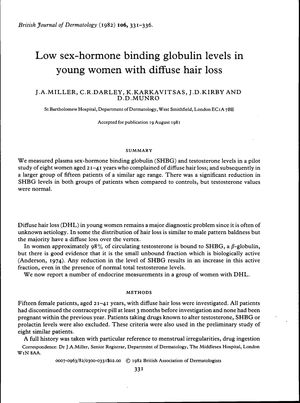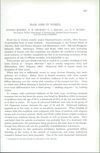Low Sex-Hormone Binding Globulin Levels in Young Women with Diffuse Hair Loss
March 1982
in “
British Journal of Dermatology
”
sex-hormone binding globulin SHBG testosterone diffuse hair loss DHL androgen activity oestrogens anti-androgens thyroid function iron status prolactin adrenal androgens male pattern hair loss circulating androgens sex-hormone binding globulin testosterone diffuse hair loss androgen activity estrogens anti-androgens thyroid function iron status prolactin adrenal androgens male pattern hair loss circulating androgens

TLDR Young women with diffuse hair loss may have low SHBG levels, which could lead to more active testosterone and contribute to their hair loss.
In a study from 1982, researchers examined the levels of sex-hormone binding globulin (SHBG) and testosterone in young women with diffuse hair loss (DHL). The study consisted of a pilot group of eight women aged 21-41 and a main study group of fifteen women in a similar age range. Results showed that both groups had significantly lower SHBG levels compared to controls, while their testosterone levels remained normal. The findings suggested that the decrease in SHBG could result in higher levels of active unbound testosterone, potentially contributing to DHL due to increased androgen activity. The study proposed that treatments involving oestrogens and anti-androgens might be effective for these women. Other potential causes for DHL, like thyroid function and iron status, were investigated and found to be normal or not significantly different from the control group. An isolated case of elevated prolactin was observed, which might be linked to higher adrenal androgen levels. The study supported the idea that male pattern hair loss and DHL in women might have a common cause related to increased levels of circulating androgens.







